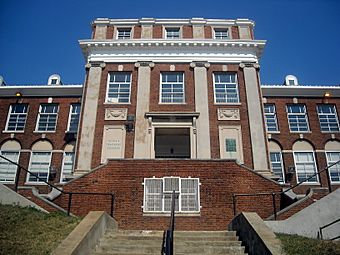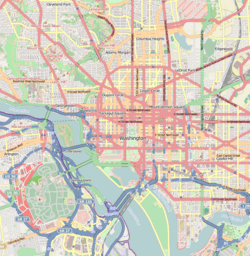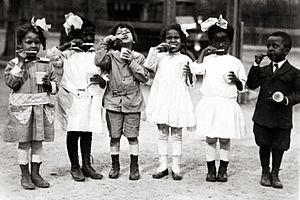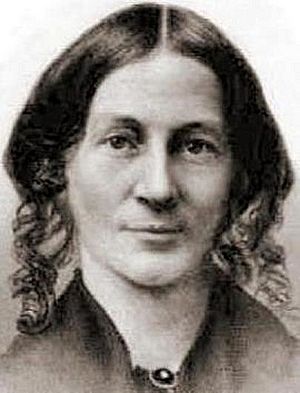Normal School for Colored Girls facts for kids
Quick facts for kids |
|
|
Miner Normal School
|
|

Miner Normal School in 2008
|
|
| Location | 2565 Georgia Ave., NW., Washington, D.C. |
|---|---|
| Built | 1913 |
| Architect | Leon E. Dessez; Snowden Ashford |
| Architectural style | Colonial Revival, Georgian Revival |
| NRHP reference No. | 91001490 |
| Added to NRHP | October 11, 1991 |
The Normal School for Colored Girls was a special school started in Washington, D.C. in 1851. Its main goal was to educate and train young African-American women, especially to help them become teachers.
Later, the school became known as Miner Normal School. It is now recognized as an important historical place on the National Register of Historic Places. Today, it is part of the University of the District of Columbia.
Contents
The School's History
How Miner School Began
A woman named Myrtilla Miner started the school in 1851. She was encouraged by Henry Ward Beecher and received money from a Quaker who liked to help others. Myrtilla Miner had wanted to teach African-American girls in Mississippi, but she wasn't allowed to.
At the time, the word "colored" was used to describe African-Americans. Some people also called the school the "Miner School for Girls."
What Students Learned
The school taught basic subjects and skills for home life. But its main focus was always on training teachers. Myrtilla Miner made sure students learned about hygiene (staying clean and healthy) and nature. They also had strong academic lessons.
Growing and Facing Challenges
The school quickly became popular. In just two months, the number of students grew from 6 to 40. Not everyone in the community supported the school, but it kept growing. Quakers continued to give money, and Harriet Beecher Stowe also helped. She gave $1,000 from the money she earned from her famous book, Uncle Tom's Cabin.
As more students joined, the school had to move three times in its first two years. In 1854, it found a permanent home on a 3-acre lot with a house and barn. Around this time, Emily Edmonson became a student. To keep everyone safe, Emily's family moved onto the school grounds. Both Emily and Myrtilla Miner even learned to shoot.
In 1856, a group of trustees took over the school's care. This group included Henry Ward Beecher and a wealthy Quaker named Johns Hopkins. By 1858, six former students were already teaching in their own schools. Myrtilla Miner's health began to fail, and by 1857, Emily Howland was in charge of the school.
The school had to close in 1860. Myrtilla Miner went to California in 1861 to try and get better. Sadly, a carriage accident in 1864 ended her hopes, and she passed away soon after returning to Washington, D.C.
During the American Civil War, on March 3, 1863, the United States Senate gave the school an official document called a "charter." This document officially named the school the "Institution for the Education of Colored Youth." It also named several directors to help run it.
From 1871 to 1876, the school worked with Howard University. In 1879, it became part of the public school system in Washington, D.C., and was called Miner Normal School.
Changes in the 20th Century
In 1929, the U.S. Congress officially recognized the school as Miner Teachers College. This college was very important for developing schools for black students in the district from the 1890s to the 1950s. Most teaching jobs in black schools during this time went to graduates from Miner. Many graduates also found jobs in other parts of the country, spreading the school's influence.
In 1955, Miner Teachers College joined with Wilson Teachers College. They formed the District of Columbia Teachers College. Later, in 1976, after more changes, the school was renamed the University of the District of Columbia.
The School Building
The building you see today was built in 1913. It was designed in the Colonial Revival and Georgian Revival styles by Leon E. Dessez and Snowden Ashford. Since it opened in 1914, the building has been used for many community education programs. It has also continuously offered classes to train teachers.
The building was officially listed on the National Register of Historic Places in 1991.
Famous People from Miner School
Students Who Made a Difference
- Aloncita Johnson Flood, a city official in New York City
- Louise Daniel Hutchinson, a historian
- Ruby Hurley, a leader in the NAACP civil rights organization
- Dolores Kendrick, a former Poet Laureate of the District of Columbia
- Alma Thomas, a famous artist
Teachers and Staff
- Martha B. Briggs, a principal from 1879 to 1883
- Marguerite Williams, an American geologist
- Otelia Cromwell, a scholar
- Hilda Rue Wilkinson Brown, a teacher and former student




